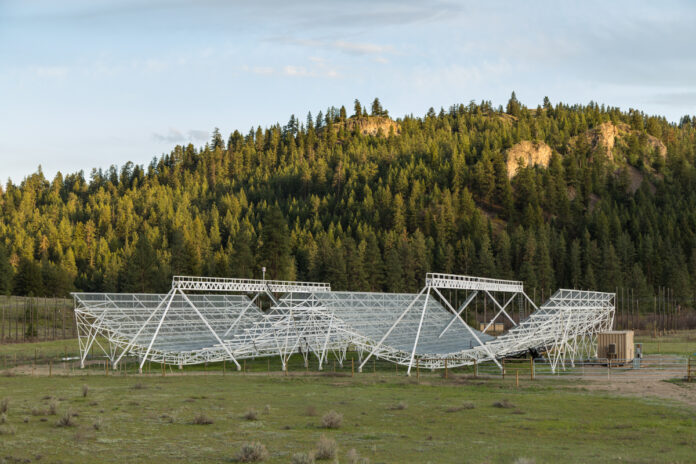
Astronomers at McGill University recently published a study on a unique signal from our universe that flashes 1,000 times longer than the average radio emission and may help researchers learn more about the universe’s rate of expansion.
Postdoctoral scholar Daniele Michilli first observed the unusual signal in 2019 while using the Canadian Hydrogen Intensity Mapping Experiment (CHIME) radio telescope near Penticton, B.C. The report was then written by Michilli and colleagues, including postdoctoral fellow Aaron Pearlman, and published this July 13.
“What was so interesting about [the signal] is that it had many of these components which first caught our eye because they appeared periodic, which had not been seen before on very short timescales like this,” Pearlman said.
These features of the signal allowed the astronomers to do a proper statistical analysis in subsequent months about whether the burst was recurring, whether it was significant and what could have caused it. The signal was quickly categorized as a fast radio burst (FRB) with an unknown origin.
“Fast radio bursts are a relatively recent discovery in the sense that we’ve only known about them for around a couple of decades,” Pearlman said. “It was quite a surprising event in the sense that the signatures of bursts detected that it was coming from way outside of our galaxy.”
The astronomers haven’t sighted the burst again since 2019, but they’ve learned more about it through their analysis. The report explains that the burst mimicked radio emissions from neutron stars in our own galaxy but shone more than a million times brighter.
But that’s not the only unique thing about the signal, categorized as FRB 20191221A. According to the report, FRBs usually only last a couple of milliseconds, making this one, which persists at three seconds long and reappears every 0.2 seconds like a heartbeat, the longest-lasting radio burst scientists have discovered.
“There’s nothing in our catalogue that we’ve published that suggests that there’s anything quite similar to this, so it’s certainly an outlier.”
Ryan McKinven, another postdoctoral researcher working at the CHIME telescope, said the speed at which the burst appears is the main reason it’s so unique and suggests it could come from a different origin than previously discovered bursts.
The two main theories behind its origins include highly magnetic neutron stars called magnetars or pulsars, but the research is still inconclusive, according to McKinven.
“This is definitely at least as rare as one in 500,” Pearlman said. “There’s nothing in our catalogue that we’ve published that suggests that there’s anything quite similar to this, so it’s certainly an outlier.”
Since FRB 20191221A was discovered, the telescope has sighted at least one FRB per day, according to Alex Hill, an adjunct scientist at the Dominion Radio Astrophysical Observatory where CHIME is based.
CHIME stands out from other telescopes due to its lack of moving parts, he explained. This means the remotely operated telescope, whether intentionally or not, is useful in real-time searches for radio bursts while a supercomputer analyzes the data on site. Standard telescopes only observe a narrow portion of the sky at a time, but CHIME scans more broadly and can detect 10 to 100 times more FRBs than all other telescopes combined.
“The two big things that are unique about CHIME are how much of the sky it can see at once and how wide a frequency range it can see over,” Hill said. “That makes it incredibly well suited, both to the cosmology mission for which it was originally built and to detect things that go off in the sky … like fast radio bursts.”
The researchers said learning about FRB 20191221A’s origins could help them understand the origins of other FRBs and measure the rate of the universe’s expansion, turning this radio burst into what McKinven called a “cosmological probe.”
“Because [FRBs are] so common, it opens up the possibility of using them as probes of the universe … whether that be the distribution of matter in the universe or possibly even things like the expansion of the universe,” he said. “I think, in order to get to that point, we’ll need to understand exactly what is the source or sources that are generating FRB emission.”
Featured image provided by Andre Recnik via Creative Commons.





